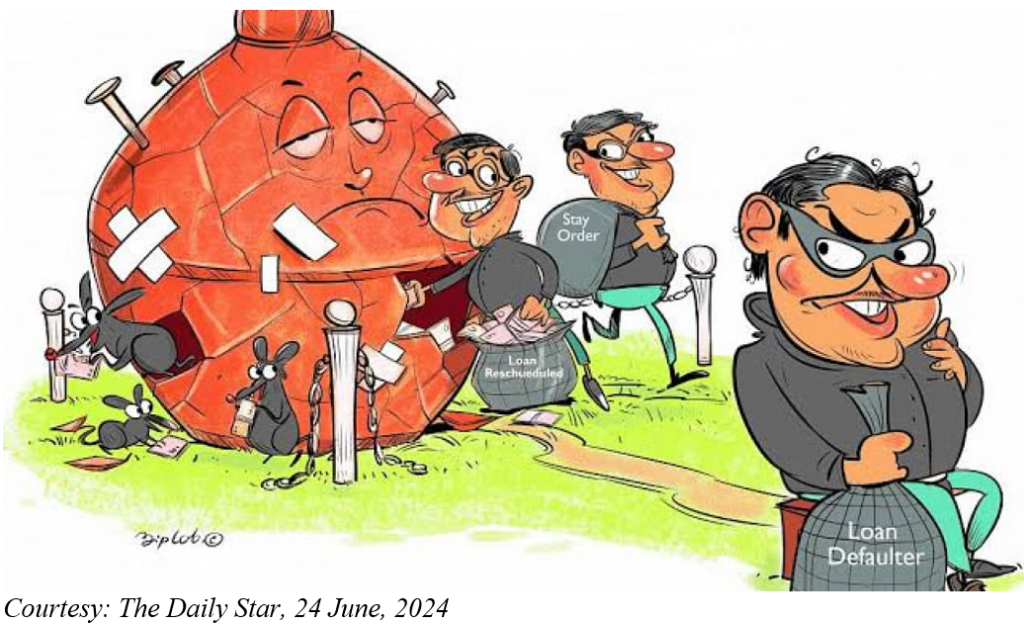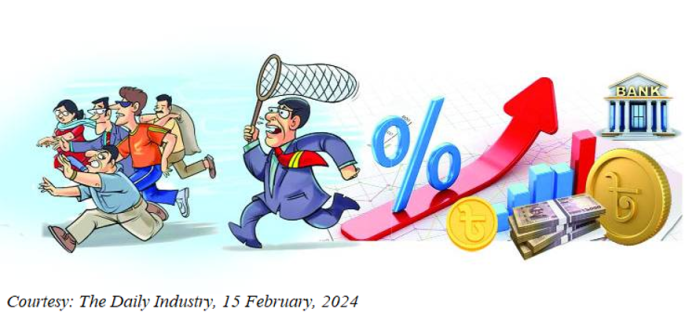Default loans in the banking sector of Bangladesh hit an all-time high of Tk 182,295 crore. Despite Bangladesh Bank (BB), the central bank of Bangladesh, offering various incentives and concessions to reduce the default loans, the total amount of default loans has increased almost seven times in the last 14 years.
According to the Bangladesh Bank’s updated report on non-performing loans, the non-performing loans in the banking sector have now exceeded Tk 1 lakh 56 thousand 39 crores. That is, currently 10.11% of the total disbursed loans of the banking sector are in default.
However, when the current government assumed power in 2009, the total default loan in the country was 22 thousand 481 crores and 41 lakhs. A decade before that in 1990, the amount of default loans in the country was 4 thousand 646 crores.
Default-loan cancer
One of the conditions that banking institutions stipulates in granting loans is to repay loan with interest within a specified period. According to the terms of the contract, if the borrower does not pay the loan or loan installments after the specified period, then the unpaid loan is called default loan or non-performing loans (NPLs).
Default loans are one of the main reasons for the weakening of the banking sector of Bangladesh, pushing the country’s economy to a challenging situation. Table 1 presents Bangladesh Bank’s default data. It shows that the ratio of NPLs to total loans remained more or less stable around 8.5%.
Table 1: Ratio of Gross NPL to Net Total Loans by Types of Banks (in %)
| Bank Types | 2013 | 2014 | 2015 | 2016 | 2017 | 2018 | 2019 | 2020 | 2021 | 2022 | End June 2023 |
| SCBs | 19.8 | 22.2 | 21.5 | 25.0 | 26.5 | 30.0 | 23.9 | 20.9 | 19.3 | 20.3 | 25.0 |
| SBs | 26.8 | 32.8 | 23.2 | 26.0 | 23.4 | 19.5 | 15.1 | 13.3 | 12.0 | 12.8 | 12.1 |
| PCBs | 4.5 | 4.9 | 4.9 | 4.6 | 4.9 | 5.5 | 5.8 | 4.7 | 5.3 | 5.1 | 6.5 |
| FCBs | 5.5 | 7.3 | 7.8 | 9.6 | 7.0 | 6.5 | 5.7 | 3.5 | 4.3 | 4.9 | 4.8 |
| Total | 8.9 | 9.7 | 8.8 | 9.2 | 9.3 | 10.3 | 9.3 | 7.7 | 7.9 | 8.2 | 10.1 |
Source: Bangladesh Bank Annual Report (July 2022-June 2023)
(Note: SCB: State owned commercial banks, SB: Specialized banks, PCB: Private commercial banks, FCB: Foreign commercial banks)
However, the International Monetary Fund (IMF) noted in May (2024) that the amount of default loans in Bangladesh is much higher than the figure given by Bangladesh Bank. According to the IMF, the Bangladesh Bank’s figure does not illustrate the full picture of defaulting on doubtful loans, loans under court order moratorium, rescheduling and restructuring loans.
Some analysts estimate that the actual volume of NPLs in Bangladesh’s banking sector is much as 5 lakh crore taka including the written-off, rescheduled and loans with court injunctions, after the central bank introduced a relaxed loan rescheduling and one-time exit policy for defaulters in 2019. This policy allowed defaulters to regularize their loans for 10 years by only paying only a 2% down payment instead of the existing 10-15%. This was a big benefit for defaulters, but a slap on the face for good borrowers.
Failed government attempts
Since the amount of default loans in Bangladesh is constantly increasing, the government has been providing to the defaulters various incentives and repeated chances of rescheduling loans to recover default loans. The IMF which pledged a loan of 4.7 billion dollars to Bangladesh has stipulated that non-performing loans in the private sector should be below 5% by 2026 and in the public sector banks should be below 10% by 2026.
However, according to the latest report of Bangladesh Bank, the rate of non-performing loans in private banks is more than 10%. The rate of default loans in government banks is also above the prescribed level.
Therefore, Bangladesh Bank announced various policies to reduce default loans. The holders of NPLs are also given the option of not being called a defaulter if they can repay half of the last installment of the loan. Despite repeated incentives, the amount of default loans has not decreased, but has increased.
In a major move by Bangladesh Bank to give further concession to defaulters, a corporate firm with various components will also have the opportunity to take loans from now on, even if a component of it fails to repay loan. Earlier, if any company of a business group defaulted, then the other companies of that business group would not be granted loans.
Due to the new law defaulters will not have any problem in getting new loans. Thus, it is feared that the growing default loans may drive the situation out of control.
Impending crisis
If a large amount of money in banks is default loans, then due to financial contagion it will have an adverse effect on the entire economy.
Having default loans means that the bank does not get any dividend from that investment. Therefore, the profit of banks decreases. If there is a negative impact on banks’ profit, a number of negative consequences may follow.
First, the government gets less tax from the banking sector. And if the government gets less tax, spending on important public sectors like education and health will decrease. The government also cannot invest from banks in infrastructure development; it has to rely on foreign loans. All these will hamper government’s development efforts.
Second, the banks’ ability to give new loans decreases. As a result, new investment will be hampered, lowering growth prospects and reducing employment opportunities. Third, a liquidity crisis may occur when the amount of money in the bank decreases. If a large amount of money in the banks is default loan, then due to financial contagion it will have an adverse effect on the entire economy. For example, many economists believe that the current declines in share prices are due to the banking sector’s fragility.
Long-term damages
Default loans affect people’s lives in both direct and indirect ways. The more the loan defaults, the more the deficit in the government’s budget will be. Banks will not be able to lend to the government under the pressure of defaulters. So, if Bangladesh Bank prints more money to lend to the government, it may increase inflation.
If the loan money was used in the manufacturing sector, the goods would have been in the market against the money. Through increase of supply of goods, it would have dampened the inflationary pressure. However, the defaulters in most cases are not using the money from these loans for manufacturing purposes; instead siphoning off from the country.
Money laundering has a deep connection with default loans or bad loans. In most cases, a large part of this money is converted into foreign currency and smuggled abroad. As a result, it is also creating pressure on the country’s foreign exchange reserves.

The general depositors of banks are suffering due to the effect of default loans. The banks are reducing the profit rate of the depositors to cover the default loans. If the amount of non-performing loans is high, naturally banks will pay deposit holders lower interest rates. Even the small shareholders of the bank are deprived of the dividends due to them.
On the other hand, good businessmen are also facing problems in getting loans, while the government is increasing the lending interest rate. High interest rates have become a burden on them. Sellers are forced to keep the price of products higher to cover this additional interest. In other words, ordinary people have to buy products at higher prices while their deposits get lower interest incomes.
Bad debt also affects the government’s revenue mobilization. Adequate revenue mobilization will become difficult because of slow progress of business and trade.
The government will have no choice but to increase taxes to balance the deficit in the government’s budget due to default loans. That too will be an indirect tax applicable to all classes of people; but will have disproportionate impacts on low-income households.
On the other hand, if some money could be collected from those defaulters through direct tax, it would be beneficial. However, the government is raising indirect taxes through value added tax.
It means that innocent common people will bear the burden of one person’s fault. The government is imposing the debt burden on these people to compensate for its losses.
If the government has a demand to spend or invest and does not get tax from where it should get fair tax, then naturally the government will increase the amount of tax in other sectors. The government is increasing the burden on indirect tax than direct tax. That is, those who are able to pay taxes will not pay, violating “ability to pay” principle of taxation.
DNA of default loans
Major reasons for the increase in default loans are: politically motivated appointment of bank managers and directors, politically motivated loan approval, lack of strong stance of the central bank, including the provision of facilities to defaulters by central bank. Default loans in Bangladesh has become a “business model” which is a perverse model of bank loans. Bangladesh must come out of this ominous situation.

Dr. Salehuddin Ahmed is Former Governor, Bangladesh Bank (Central Bank), and currently Professor, Business School, BRAC University. Dr. Ahmed has Masters and BA (Honours) degrees in Economics from Dhaka University and a Ph.D. degree from McMaster University (Canada). He joined the Pakistan Civil Service in 1971 and served in various capacities in the field of administration for the Government of Bangladesh. A progressive thinker, Dr. Ahmed has authored more than 80 books, reports and journal articles, published at home and abroad.




